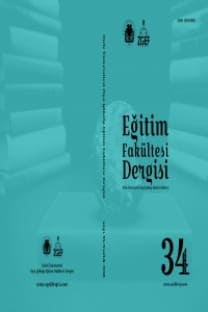MATEMATİK ÖĞRETİMİNDE GEOGEBRA KULLANIMI HAKKINDA ÖĞRENCİ GÖRÜŞLERİNİN DEĞERLENDİRİLMESİ
Matematik, Dinamik Matematik Yazılımı, GeoGebra, Öğrenci
EVALUATION OF VIEWS OF STUDENTS ABOUT USING GEOGEBRA IN TEACHING OF MATHEMATICS
Mathematics, Dynamic Mathematics Software, GeoGebra, Student,
___
- Baki, A. (2002). Öğrenen ve Öğretenler İçin Bilgisayar Destekli Matematik, İstanbul: BİTAV- Ceren Yayın Dağıtım.
- Baydaş, Ö. (2010). Öğretim Elemanlarının ve Öğretmen Adaylarının Görüşleri Işığında Matematik Öğretiminde Geogebra Kullanımı. Yayımlanmamış Yüksek Lisans Tezi. Atatürk Üniversitesi. Erzurum.
- Carr, A. A. (1996). Distingurshing Systemic From Systematic Teach Trend for Leadership in Education and Training, London.
- Cohen, L ve Manion, L. (1994). Research Method in Education (Fourth Edition). New York Routledge.
- Dikovic, L. (2009). Implementing Dynamic Mathematics Resources with GeoGebra at the College Level. International Journal of Emerging Technologies in Learning (IJET), 1 (3).
- Duval, R., 1999. Representation, vision and visualization: Cognitive fonctions in mathematical thinking. Basic issues for leraning. Proceedings of the International Group for the Psychology of Mathematics Education. Morelos- Mexico
- Gürbüz, R. (2007). Olasılık Konusunda Geliştirilen Materyallere Dayalı Öğretime İlişkin Öğretmen ve Öğrenci Görüşleri, Kastamonu Üniversitesi Kastamonu Eğitim Dergisi, 15 (1), 259-270.
- Hacıömeroğlu, E. S., Lingguo, B., Schoen R. C., Hohenwarter, M., (2009). “Learning to Develop Mathematics Lessons with GeoGebra”, MSOR Connections, 9(2).
- Hohenwarter, J., Hohenwarter, M., ve Lavicza, Z. (2010). Evaluating Difficulty Levels of Dynamic Geometry Software Tools to Enhance Teachers’ Professional Development. International Journal for Technology in Mathematics Education, 17 (3).
- Hohenwarter, M. (2006). GeoGebra - didaktische Materialien und Anwendungen für den Mathematikunterricht. Unpublished doctoral thesis. University of Salzburg, Salzburg.
- Hohenwarter, M., ve Jones, K. (2007). Ways of Linking Geometry and Algebra: The Case of GeoGebra, Proceedings of British Society for Research into Learning Mathematics, 27 (3).
- Hohenwarter, M., ve Lavicza, Z. (2007). Mathematics Teacher Development with ICT: Towards an International GeoGebra Institute, Proceedings of British Society for Research into Learning Mathematics, 27.
- Kutluca, T., (2009). İkinci Dereceden Fonksiyonlar Konusu İçin Tasarlanan Bilgisayar Destekli Öğrenme Ortamının Değerlendirilmesi. Yayımlanmamış Doktora Tezi. Karadeniz Teknik Üniversitesi, Fen Bilimleri Enstitüsü, Trabzon.
- Kutluca, T., ve Baki, A. (2009). 10. Sınıf Matematik Dersinde Zorlanılan Konular Hakkında Öğrencilerin, Öğretmen Adaylarının ve Öğretmenlerin Görüşlerinin İncelenmesi, Kastamonu Üniversitesi Kastamonu Eğitim Dergisi, 17, 2, 616-632.
- Milli Eğitim Bakanlığı Talim ve Terbiye Kurulu Başkanlığı, (2005). Matematik Dersi Öğretim Programı ve Kılavuzu ( 9-12. Sınıflar), Ankara.
- Piaget, J. (1952). The Child’s Conception of Number, Humanities press, New York.
- Preiner, J. (2008). Introducing Dynamics Mathematics Software to Mathematics Teacher: the Case of GeoGebra. Dissertation in Mathematics Education, University of Salzburg.
- Reis, Z. A. (2010). Computer Supported With GeoGebra. Procedia Social and Behavioral Sciences 9, 1449-1455.
- Reis, Z. A. ve Özdemir, Ş. (2010). Using Geogebra as an Information Technology Tool: Parabola Teaching. Procedia Social and Behavioral Sciences 9, 565-572.
- Saha, R. A., Ayub, A. F. M., ve Tarmizi, R. A. (2010). The Effect of GeoGebra on Mathematics Achievement: Enlightening Coordinate Geometry Learning. Procedia Social and Behavioral Sciences 8, 686-693.
- Şahin, S., ve Yıldırım, Y.Ş. (1999). Öğretim Teknolojileri ve Materyal Geliştirme. Ankara: Anı Yayıncılık.
- Yager, R.E. (1991). The Constructivist Learning Model: Towards Real Reform in Science Education. The Science Teacher, 58 (6), 52-57.
- Yıldırım, A. ve Şimşek, H. (2006). Sosyal Bilimlerde Nitel Araştırma Yöntemleri (5. Baskı). Ankara: Seçkin Yayıncılık.
- Zaslavsky, O. (1997). Conceptual Obstacles in the Learning of Quadratic Functions. Focus on Learning Problems in Mathematics, 19 (1), 20-45.
- Zazkis, R., Liljedahl, P. ve Gadowsky, K. (2003). Conceptions of Function Translation: Obstacles, Intuitions and Rerouting. Journal of Mathematical Behavior, 22(4), 437- 450.
- ISSN: 1305-0060
- Yayın Aralığı: Yılda 2 Sayı
- Başlangıç: 1995
- Yayıncı: Dicle Üniversitesi
Mehmet Nuri GÖMLEKSİZ, Sare ÇETİNTAŞ
İLKÖĞRETİM ÖĞRENCİLERİNİN ÇOKLU ZEKA ALANLARI İLE YARATICI DÜŞÜNME DÜZEYLERİ ARASINDAKİ İLİŞKİ
Kürşat YENİLMEZ, Serap ÇALIŞKAN
MATEMATİKSEL PROBLEM ÇÖZMEYE İLİŞKİN İNANÇ ÖLÇEĞİ’NİN TÜRKÇE’YE UYARLAMA ÇALIŞMASI
FEN ÖĞRETİMİNDE BİLGİ HARİTASI KULLANIMI: EKOSİSTEM ÖRNEĞİ
Orhan KARAMUSTAFAOĞLU, Ahmet BACANAK, Sevilay KARAMUSTAFAOĞLU, Salih DEĞİRMENCİ
Mustafa METİN, Salih BİRİŞÇİ, Kerem COŞUN, Gül Kaleli YILMAZ
SINIF ÖĞRETMENLERİNİN SINIFLARINDA KARŞILAŞTIKLARI OKUMA GÜÇLÜKLERİNE İLİŞKİN NİTEL BİR ARAŞTIRMA
Taner Altun, Durmuş EKİZ, Merve ODABAŞI
İÇ SALGI BEZLERİMİZ KONUSUNDA UYGULANAN KAVRAM HARİTALARININ ÖĞRENCİLERİN AKADEMİK BAŞARISINA ETKİSİ
Mürşet ÇAKMAK, Aysel TEMELLİ, Banu Çiçek Seyhan
MATEMATİK ÖĞRETİMİNDE GEOGEBRA KULLANIMI HAKKINDA ÖĞRENCİ GÖRÜŞLERİNİN DEĞERLENDİRİLMESİ
